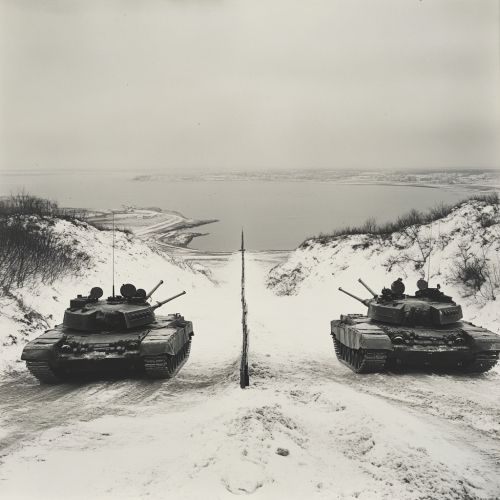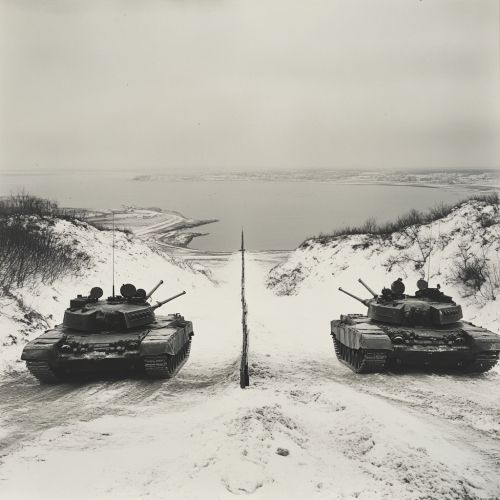Balance of Power: Difference between revisions
(Created page with "== Introduction == The concept of the "Balance of Power" is a fundamental principle in international relations and political science. It refers to a situation in which the power held by various states is distributed in such a way that no single state or coalition of states can dominate or interfere with the interests of others. This principle has been a cornerstone of diplomatic strategy and military planning throughout history, influencing the policies and actions of na...") |
No edit summary |
||
| Line 34: | Line 34: | ||
The Cold War (1947-1991) between the United States and the Soviet Union is a prime example of a bipolar balance of power. Both superpowers sought to expand their influence while preventing the other from achieving dominance. This period saw the formation of military alliances such as [[NATO]] and the [[Warsaw Pact]], as well as numerous proxy wars and diplomatic confrontations. | The Cold War (1947-1991) between the United States and the Soviet Union is a prime example of a bipolar balance of power. Both superpowers sought to expand their influence while preventing the other from achieving dominance. This period saw the formation of military alliances such as [[NATO]] and the [[Warsaw Pact]], as well as numerous proxy wars and diplomatic confrontations. | ||
[[Image:Detail-97669.jpg|thumb|center|Two opposing military forces facing each other across a border, symbolizing the balance of power during the Cold War.|class=only_on_mobile]] | |||
[[Image:Detail-97670.jpg|thumb|center|Two opposing military forces facing each other across a border, symbolizing the balance of power during the Cold War.|class=only_on_desktop]] | |||
=== Asia in the 21st Century === | === Asia in the 21st Century === | ||
Latest revision as of 03:46, 19 August 2024
Introduction
The concept of the "Balance of Power" is a fundamental principle in international relations and political science. It refers to a situation in which the power held by various states is distributed in such a way that no single state or coalition of states can dominate or interfere with the interests of others. This principle has been a cornerstone of diplomatic strategy and military planning throughout history, influencing the policies and actions of nations.
Historical Development
The idea of the balance of power has ancient roots, with early examples found in the political dynamics of ancient Greece and Rome. However, it gained prominence during the Renaissance and the early modern period in Europe. The Peace of Westphalia in 1648, which ended the Thirty Years' War, is often cited as a key moment in the development of the modern state system and the balance of power concept.
During the 18th and 19th centuries, the balance of power was a central theme in European diplomacy. The Congress of Vienna in 1815, which aimed to restore stability after the Napoleonic Wars, is a notable example of efforts to maintain a balance of power. The Congress established a framework for international relations that sought to prevent any one state from becoming too powerful.
Theoretical Foundations
The balance of power theory is rooted in realist thought, which emphasizes the competitive and conflictual nature of international relations. Realists argue that states are primarily concerned with their own survival and security, leading them to seek a balance of power to prevent domination by others. Key figures in the development of realist theory include Machiavelli, Hobbes, and Morgenthau.
The theory posits that states will form alliances and counter-alliances to balance the power of potential adversaries. This can involve military build-ups, diplomatic negotiations, and economic strategies. The balance of power is seen as a dynamic and fluid process, constantly shifting in response to changes in the international system.
Mechanisms of Balance
There are several mechanisms through which states seek to achieve a balance of power:
Alliances
States often form alliances to counterbalance a more powerful adversary. These alliances can be formal, such as treaties, or informal understandings. The Triple Alliance and the Triple Entente before World War I are classic examples of alliances formed to maintain a balance of power in Europe.
Arms Races
Military build-ups and arms races are another mechanism for achieving balance. By increasing their military capabilities, states aim to deter potential aggressors. The Cold War arms race between the United States and the Soviet Union is a prominent example of this strategy.
Diplomacy
Diplomatic efforts, including negotiations, treaties, and international organizations, play a crucial role in maintaining the balance of power. The United Nations and other international bodies are designed to facilitate cooperation and prevent conflicts that could disrupt the balance.
Economic Strategies
Economic policies, such as trade agreements and sanctions, can also influence the balance of power. States may use economic leverage to weaken adversaries or strengthen allies.
Case Studies
Europe in the 19th Century
The 19th century in Europe is often cited as a period where the balance of power was actively managed through diplomacy and alliances. The Concert of Europe, established after the Congress of Vienna, was a system of dispute resolution among the major powers aimed at maintaining the balance and preventing major conflicts.
The Cold War
The Cold War (1947-1991) between the United States and the Soviet Union is a prime example of a bipolar balance of power. Both superpowers sought to expand their influence while preventing the other from achieving dominance. This period saw the formation of military alliances such as NATO and the Warsaw Pact, as well as numerous proxy wars and diplomatic confrontations.


Asia in the 21st Century
In the contemporary era, the rise of China and its growing influence in Asia has led to new dynamics in the balance of power. The United States, along with regional allies such as Japan and India, has sought to counterbalance China's influence through military cooperation, economic partnerships, and diplomatic initiatives.
Criticisms and Alternatives
While the balance of power theory has been influential, it has also faced criticism. Critics argue that it can lead to an arms race and increased tensions, potentially escalating conflicts rather than preventing them. Additionally, the theory may not adequately account for the role of non-state actors and transnational issues such as terrorism and climate change.
Alternative theories, such as liberalism and constructivism, offer different perspectives on international relations. Liberalism emphasizes the role of international institutions, economic interdependence, and democratic governance in promoting peace and stability. Constructivism focuses on the importance of ideas, norms, and identities in shaping state behavior and international outcomes.
Conclusion
The balance of power remains a central concept in the study of international relations. It has shaped the policies and strategies of states for centuries and continues to influence contemporary global politics. Understanding the mechanisms and dynamics of the balance of power is essential for analyzing historical and current international events.
